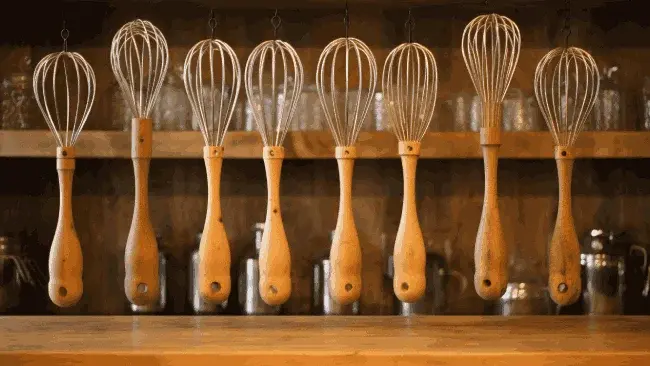Properly storing kitchen utensils is essential to maintain functionality and hygiene. The whisk is no exception. You can extend the lifespan of your whisk and ensure it’s always ready for your culinary adventures by knowing how a whisk should be stored.
To properly store your whisk in the kitchen, clean it thoroughly with warm soapy water and dry it completely. Prepare the whisk for storage by folding the wires and securing them with a rubber band or twist tie.
Consider hanging the whisk on a utensil rack or storing it in a drawer with other kitchen tools for storage options.
Throughout this article, we’ll discuss the ideal way to store a whisk in your kitchen. As well, you will know where it should not be stored and whether it should be stored in the refrigerator.
Jump to Section
How Should a Whisk Be Stored in Your Kitchen?

Whisk are generally quite easy to store and maintain. However, improper storage techniques may cause the item to lose its hygiene and shorten its lifespan. Keep your whisk stored properly by following these steps:
- Step 01: Clean your whisk
- Step 02: Prepare the whisk for storage
- Step 03: Choose storage options
- Step 04: Regular maintenance (optional)
Step 01: Clean Your Whisk
When you’re finished whisking, we recommend cleaning your whisk thoroughly to remove any residue left behind. Rinse the whisk under hot water, making sure to get rid of any remaining food particles.
We also recommend avoiding placing it in the dishwasher, which can damage the whisk. Instead, use hot water to ensure a proper clean.
Pay special attention to the bristles and handle, as these areas can accumulate residue. After rinsing, gently shake off any excess water and allow the whisk to air dry.
Step 02: Prepare the Whisk for Storage
Ensure you wrap your bamboo whisk in a paper towel before storing it in your kitchen. By wrapping the whisk in a paper towel, you create a barrier that prevents moisture from seeping into the bristles.
Also, the paper towel helps to absorb any excess moisture that may be present on the whisk, further protecting it from potential damage.
When storing metal whisks, such as those used for pottery, it’s recommended to use protective covers or bags to shield them from moisture. These covers can help prevent rust formation and keep the whisk in optimal condition.
Step 03: Choose Storage Options
When storing your whisk in the kitchen, we recommend considering two options. One option is to store it in a drawer and another is to store it on the countertop.
1. Drawer Storage With Rubber Bands
For efficient drawer storage, you should always securely fasten rubber bands around your whisk’s wires. This simple solution will compress the whisk, preventing the wide wires from snagging under the drawer’s lip when opening or becoming bent when closing.
But, you should note that flat, shallow drawers may not be suitable for storing whisks, even with rubber bands. Consider using a different storage option for these drawers to avoid potential damage.
2. Countertop Upright Storage
Consider using a utensil holder or container to store your whisk upright on your countertop for easy access and to prevent bent wires. Storing your whisk this way ensures that it’s always within reach when you need it for whipping up eggs, cream, or batter.
But, storing whisks in an overcrowded utensil holder is not ideal. When surrounded by other utensils, the whisk wires can become entangled or bent from pressure. It’s essential to provide sufficient space to keep the whisk accessible and in good condition.
Step 04: Regular Maintenance (Optional)
To ensure the longevity of your whisk, we advise you to periodically inspect it for any signs of wear, damage, or rust while storing it.
Examine the wires of the whisk for any signs of bending or fraying. If you notice any issues, addressing them promptly is crucial to avoid further damage.
Also, check for any rust formation on the metal parts. If you spot any rust, gently scrub it off with a brush and mild detergent before rinsing with warm water. You may also want to periodically oil the whisk wires to prevent rust formation and extend their life.
When coating your whisk with oil, use a food-grade oil like vegetable or mineral oil. This thin layer of oil will act as a protective barrier, preventing rust from forming during storage.
Where Should You Not Store a Whisk in a Kitchen?

According to kitchen experts, you should avoid some storage locations when placing a whisk in your kitchen.
No 01: Flat Trays or Platters
Don’t store your whisk on flat trays or platters in the kitchen. While it may seem convenient, this storage method can lead to a tangled mess and potentially damage your whisk.
Flat trays and platters provide little support, causing your whisk to slide and become disorganized. This constant movement can result in the wires of the whisk getting tangled, making it difficult to use and potentially causing damage to the wires.
Also, if you need to move the tray frequently, the whisk can easily fall off or get knocked over, leading to further damage.
No 02: Low-Hanging Hooks or Pegs
Avoid hanging your whisk on low hooks or pegs in the kitchen, as this can lead to bent wires and potential accidents. It’s strongly recommended to store your whisk properly to maintain its integrity and ensure your safety.
Instead of using low hanging hooks or pegs, opt for hooks or pegs at an appropriate height where the whisk can hang freely without any stress on its wires. This will prevent accidental wires bending and reduce the risk of accidents when brushing against the whisk.
No 03: Moisture-Prone Areas
Near the sink or dishwasher aren’t suitable places to store a whisk in a kitchen, as the moisture in these areas can lead to mold growth or rust formation. Moisture is the enemy when storing whisks, as it can compromise their hygiene and functionality.
Bamboo whisks are particularly vulnerable to mold growth, negatively impacting your health and food taste. Conversely, metal whisks can develop rust when exposed to moisture, making them less effective at whisking and potentially contaminating your ingredients.
FAQ’s: How Should a Whisk Be Stored
1. How should a whisk be stored in the fridge?
Before storing a whisk in your fridge, thoroughly clean it by rinsing off any residue and ensuring it’s completely dry. It will prevent unwanted food odors.
Once clean, place the whisk in an airtight container or a resealable plastic bag to maintain its cleanliness and functionality. It’s recommended to choose the container or bag in a designated area within the fridge. Your whisk will be protected from cross-contamination from foods with strong smells.
2. How do you store matcha whisk without a holder?
You can easily store your matcha whisk without a holder by placing it in a tall glass or utensil container.
After using the matcha whisk, rinse it with hot water to remove any remaining matcha residue. Then, let the whisk air dry with the bristles pointing downward. This will help preserve the whisk’s shape and quality over time.
Once the whisk is completely dry, you can store it in a clean and dry place, such as a drawer or a utensil container. Keeping the whisk upright is important to maintain its shape and protect it from moisture and dust.
3. Can I store a whisk in a wooden utensil holder?

Storing a whisk in a wood utensil holder is acceptable as long as it’s dry and it is clean and spacious enough to accommodate it. Before placing the whisk in the holder, it’s recommended to dry it completely to prevent any moisture from causing mold or mildew growth.
Also, keep the utensil holder clean and free of any moisture. This will ensure that your whisk stays in good condition and is ready for use whenever needed.
Conclusion
In the kitchen, where organization and care for your tools play a vital role, knowing how to store a whisk will make cooking and baking easier.
It is possible to keep your whisks in pristine condition if you follow the guidelines provided and consider the unique storage options available. Whisks should be properly stored in a drawer, a utensil crock, or even displayed as kitchen decor.
Avoid storing it in areas that can cause harm, such as near heat sources or sharp objects. Treating your whisk with care is essential. It’s like a superhero tool in the kitchen, always ready to save the day.


![How Should a Whisk Be Stored: 4 Steps [Improve Longevity]](https://tidytango.com/wp-content/uploads/2023/10/How-Should-a-Whisk-Be-Stored-4-Steps-Improve-Longevity-900x473.webp)
![How to Store Tongs Safely in the Kitchen Drawer: 5 Steps [DIY]](https://tidytango.com/wp-content/uploads/2023/10/How-to-Store-Tongs-Safely-in-the-Kitchen-Drawer-5-Steps-DIY-480x252.webp)

